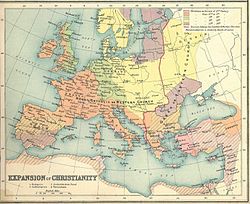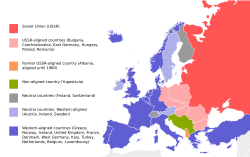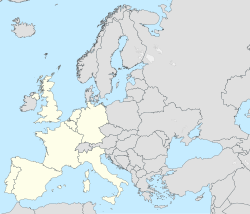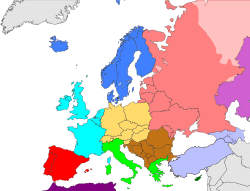| Revision as of 14:45, 28 February 2024 edit2a04:4a43:88df:f730:39cd:f49f:ca7a:c3be (talk)No edit summaryTags: Visual edit Mobile edit Mobile web edit← Previous edit | Revision as of 14:55, 28 February 2024 edit undo2a04:4a43:88df:f730:39cd:f49f:ca7a:c3be (talk) moved image under relevant heading, with correct depictionTags: Mobile edit Mobile web editNext edit → | ||
| Line 32: | Line 32: | ||
| ]; neutral countries (shaded gray or light blue) considered informally Western-oriented but not formally aligned to the West]] | ]; neutral countries (shaded gray or light blue) considered informally Western-oriented but not formally aligned to the West]] | ||
| During the four decades of the ], the definition of East and West was simplified by the existence of the ]. |
During the four decades of the ], the definition of East and West was simplified by the existence of the ]. A number of historians and social scientists view the Cold War definition of Western and Eastern Europe as outdated or relegating.<ref name="cotf.edu">"One very common, but now outdated, definition of Eastern Europe was the Soviet-dominated communist countries of Europe."http://www.cotf.edu/earthinfo/balkans/BKdef.html {{Webarchive|url=https://web.archive.org/web/20171210020555/http://www.cotf.edu/earthinfo/balkans/BKdef.html |date=10 December 2017 }}</ref><ref name="review">"Too much writing on the region has – consciously or unconsciously – clung to an outdated image of 'Eastern Europe', desperately trying to patch together political and social developments from Budapest to Bukhara or Tallinn to Tashkent without acknowledging that this Cold War frame of reference is coming apart at the seams. {{Webarchive|url=https://web.archive.org/web/20171031132532/http://www.ce-review.org/99/1/hanley1.html |date=31 October 2017 }}</ref><ref>{{Cite book |last1=Berglund |first1=Sten |last2=Ekman |first2=Joakim |last3=Aarebrot |first3=Frank H. |title=The handbook of political change in Eastern Europe |page=2 |year=2004 |url= https://books.google.com/books?id=HeRzzwzdfPkC&q=Eastern+Europe+term+outdated&pg=PA2 |access-date=5 October 2011 |quote=The term 'Eastern Europe' is ambiguous and in many ways outdated. |isbn=978-1-78195-432-4 }}</ref> | ||
| During the final stages of ], the future of Europe was decided between the ] in the 1945 ], between the ], ], the ], ], and the ], ]. | During the final stages of ], the future of Europe was decided between the ] in the 1945 ], between the ], ], the ], ], and the ], ]. | ||
| Line 41: | Line 41: | ||
| Although some countries were officially ], they were classified according to the nature of their political and economic systems. This division largely defines the popular perception and understanding of Western Europe and its borders with ]. | Although some countries were officially ], they were classified according to the nature of their political and economic systems. This division largely defines the popular perception and understanding of Western Europe and its borders with ]. | ||
| ] – its members and associates]] | |||
| The world changed dramatically with the fall of the ] in 1989. ] peacefully absorbed ], in the ]. ] and the ] were dissolved, and in 1991, the ] ceased to exist. Several countries which had been part of the Soviet Union regained full independence. | The world changed dramatically with the fall of the ] in 1989. ] peacefully absorbed ], in the ]. ] and the ] were dissolved, and in 1991, the ] ceased to exist. Several countries which had been part of the Soviet Union regained full independence. | ||
| ===Western European Union=== | ===Western European Union=== | ||
| ] (1990-1995)]] | |||
| In 1948 the ] was signed between ], ], ], the ] and the ]. It was further revisited in 1954 at the ], when the ] was established. It was declared defunct in 2011 after the ], and the Treaty of Brussels was terminated. When the Western European Union was dissolved, it had 10 member countries, six associate member countries, five observer countries and seven associate partner countries. | In 1948 the ] was signed between ], ], ], the ] and the ]. It was further revisited in 1954 at the ], when the ] was established. It was declared defunct in 2011 after the ], and the Treaty of Brussels was terminated. When the Western European Union was dissolved, it had 10 member countries, six associate member countries, five observer countries and seven associate partner countries. | ||
Revision as of 14:55, 28 February 2024
Subregion of the European continent Not to be confused with Western European Union.
Western Europe is the western region of Europe. The region's extent varies depending on context.
The concept of "the West" appeared in Europe in juxtaposition to "the East" and originally applied to the ancient Mediterranean world, the Roman Empire (both Western and Eastern), and medieval "Christendom". Beginning with the Renaissance and the Age of Discovery, roughly from the 15th century, the concept of Europe as "the West" slowly became distinguished from and eventually replaced the dominant use of "Christendom" as the preferred endonym within the region. By the Age of Enlightenment and the Industrial Revolution, the concepts of "Eastern Europe" and "Western Europe" were more regularly used, Western Europe comprised those countries which were industrialised and conformed to the ideals of the enlightenment. The distinctiveness of Western Europe became most apparent during the Cold War, when Europe was divided for 40 years by the Iron Curtain into the Western Bloc and Eastern Bloc, each characterised by distinct political and economical systems. Several European countries remained neutral during this period, maintaining diplomatic relations with both the Western and Eastern Bloc.
Historical divisions
| This section possibly contains original research. Please improve it by verifying the claims made and adding inline citations. Statements consisting only of original research should be removed. (September 2020) (Learn how and when to remove this message) |
Classical antiquity and medieval origins

Prior to the Roman conquest, a large part of Western Europe had adopted the newly developed La Tène culture. As the Roman domain expanded, a cultural and linguistic division appeared between the mainly Greek-speaking eastern provinces, which had formed the highly urbanized Hellenistic civilization, and the western territories, which in contrast largely adopted the Latin language. This cultural and linguistic division was eventually reinforced by the later political east–west division of the Roman Empire. The Western Roman Empire and the Eastern Roman Empire controlled the two divergent regions between the 3rd and the 5th centuries.
The division between these two was enhanced during Late antiquity and the Middle Ages by a number of events. The Western Roman Empire collapsed, starting the Early Middle Ages. By contrast, the Eastern Roman Empire, mostly known as the Greek or Byzantine Empire, survived and even thrived for another 1000 years. The rise of the Carolingian Empire in the west, and in particular the Great Schism between Eastern Orthodoxy and Roman Catholicism, enhanced the cultural and religious distinctiveness between Eastern and Western Europe.
After the conquest of the Byzantine Empire, center of the Eastern Orthodox Church, by the Muslim Ottoman Empire in the 15th century, and the gradual fragmentation of the Holy Roman Empire (which had replaced the Carolingian Empire), the division between Roman Catholic and Protestant became more important in Europe than that with Eastern Orthodoxy.
In East Asia, Western Europe was historically known as taixi in China and taisei in Japan, which literally translates as the "Far West". The term Far West became synonymous with Western Europe in China during the Ming dynasty. The Italian Jesuit priest Matteo Ricci was one of the first writers in China to use the Far West as an Asian counterpart to the European concept of the Far East. In Ricci's writings, Ricci referred to himself as "Matteo of the Far West". The term was still in use in the late 19th and early 20th centuries.
Religion
Christianity is the largest religion in Western Europe. According to a 2018 study by the Pew Research Center, 71.0% of Western Europeans identified as Christians.
In 1054, the East–West Schism divided Christianity into Western Christianity and Eastern Christianity. This split Europe in two, with Western Europe primarily under the Catholic Church, and Eastern Europe primarily under the Eastern Orthodox Church. Ever since the Reformation in the 16th century, the primary Christian denominations in Western Europe have been Catholicism and Protestantism.
Under this definition of Eastern and Western Europe, Eastern Europe contains Southeastern European countries as well, while Western Europe includes Northern and Central European countries.
Cold War

During the four decades of the Cold War, the definition of East and West was simplified by the existence of the Eastern Bloc. A number of historians and social scientists view the Cold War definition of Western and Eastern Europe as outdated or relegating.
During the final stages of World War II, the future of Europe was decided between the Allies in the 1945 Yalta Conference, between the British Prime Minister, Winston Churchill, the U.S. President, Franklin D. Roosevelt, and the Premier of the Soviet Union, Joseph Stalin.
Post-war Europe was divided into two major spheres: the Western Bloc, influenced by the United States, and the Eastern Bloc, influenced by the Soviet Union. With the onset of the Cold War, Europe was divided by the Iron Curtain. This term had been used during World War II by German Propaganda Minister Joseph Goebbels and, later, Count Lutz Schwerin von Krosigk in the last days of the war; however, its use was hugely popularized by Winston Churchill, who used it in his famous "Sinews of Peace" address on 5 March 1946 at Westminster College in Fulton, Missouri:
From Stettin in the Baltic to Trieste in the Adriatic an iron curtain has descended across the Continent. Behind that line lie all the capitals of the ancient states of Central and Eastern Europe. Warsaw, Berlin, Prague, Vienna, Budapest, Belgrade, Bucharest and Sofia; all these famous cities and the populations around them lie in what I must call the Soviet sphere, and all are subject, in one form or another, not only to Soviet influence but to a very high and in some cases increasing measure of control from Moscow.
Although some countries were officially neutral, they were classified according to the nature of their political and economic systems. This division largely defines the popular perception and understanding of Western Europe and its borders with Eastern Europe.
The world changed dramatically with the fall of the Iron Curtain in 1989. West Germany peacefully absorbed East Germany, in the German reunification. Comecon and the Warsaw Pact were dissolved, and in 1991, the Soviet Union ceased to exist. Several countries which had been part of the Soviet Union regained full independence.
Western European Union

In 1948 the Treaty of Brussels was signed between Belgium, France, Luxembourg, the Netherlands and the United Kingdom. It was further revisited in 1954 at the Paris Conference, when the Western European Union was established. It was declared defunct in 2011 after the Treaty of Lisbon, and the Treaty of Brussels was terminated. When the Western European Union was dissolved, it had 10 member countries, six associate member countries, five observer countries and seven associate partner countries.
Modern divisions
UN geoscheme classification

Eastern Europe Northern Europe Southern Europe Western Europe
The United Nations geoscheme is a system devised by the United Nations Statistics Division (UNSD) which divides the countries of the world into regional and subregional groups, based on the M49 coding classification. The partition is for statistical convenience and does not imply any assumption regarding political or other affiliation of countries or territories.
In the UN geoscheme, the following countries are classified as Western Europe:
CIA classification

The CIA classifies seven countries as belonging to "Western Europe":
The CIA also classifies three countries as belonging to "Southwestern Europe":
EuroVoc classification

EuroVoc is a multilingual thesaurus maintained by the Publications Office of the European Union. In this thesaurus, the countries of Europe are grouped into sub-regions. The following countries are included in the sub-group Western Europe:
- Andorra
- Austria
- Belgium
- France
- Germany
- Ireland
- Liechtenstein
- Luxembourg
- Monaco
- Netherlands
- Switzerland
- United Kingdom
UN regional groups: Western European and Others Group

The Western European and Others Group is one of several unofficial Regional Groups in the United Nations that act as voting blocs and negotiation forums. Regional voting blocs were formed in 1961 to encourage voting to various UN bodies from different regional groups. The European members of the group are:
- Andorra
- Austria
- Belgium
- Denmark
- Finland
- France
- Germany
- Greece
- Iceland
- Ireland
- Italy
- Liechtenstein
- Luxembourg
- Malta
- Monaco
- Netherlands
- Norway
- Portugal
- San Marino
- Spain
- Sweden
- Switzerland
- Turkey
- United Kingdom
In addition, Australia, Canada, Israel and New Zealand are members of the group, with the United States as observer.
Population
Using the CIA classification strictly would give the following calculation of Western Europe's population. All figures based on the projections for 2018 by the Population Division of the United Nations Department of Economic and Social Affairs.
| Rank | Country or territory | Population (most recent estimates) |
Languages | Capital |
|---|---|---|---|---|
| 1 | United Kingdom | 66,040,229 | English | London |
| 2 | France (metropolitan) | 65,058,000 | French | Paris |
| 3 | Netherlands | 17,889,600 | Dutch, Frisian | Amsterdam |
| 4 | Belgium | 11,420,163 | Dutch, French and German | Brussels |
| 5 | Ireland | 5,123,536 | English, Irish | Dublin |
| 6 | Luxembourg | 602,005 | French, Luxembourgish and German | Luxembourg City |
| 7 | Monaco | 38,300 | French | Monaco (city-state) |
| Total | 165,265,329 |
Using the CIA classification a little more liberally and including "South-Western Europe", would give the following calculation of Western Europe's population.
| Rank | Country or territory | Population (most recent estimates) |
Languages | Capital |
|---|---|---|---|---|
| 1 | United Kingdom | 66,040,229 | English | London |
| 2 | France (metropolitan) | 65,058,000 | French | Paris |
| 3 | Spain | 46,700,000 | Spanish | Madrid |
| 4 | Netherlands | 17,889,600 | Dutch, Frisian | Amsterdam |
| 5 | Belgium | 11,420,163 | Dutch, French and German | Brussels |
| 6 | Portugal | 10,291,027 | Portuguese | Lisbon |
| 7 | Ireland | 5,123,536 | English, Irish | Dublin |
| 8 | Luxembourg | 602,005 | French, Luxembourgish and German | Luxembourg City |
| 9 | Andorra | 78,264 | Catalan | Andorra la Vella |
| 10 | Monaco | 38,300 | French | Monaco (city-state) |
| Total | 222,293,922 |
The Hague is the seat of government
Climate

The climate of Western Europe varies from Mediterranean in the coasts of Italy, Portugal and Spain to alpine in the Pyrenees and the Alps. The Mediterranean climate of the south is dry and warm. The western and northwestern parts have a mild, generally humid climate, influenced by the North Atlantic Current. Western Europe is a heatwave hotspot, exhibiting upward trends that are three-to-four times faster compared to the rest of the northern midlatitudes.
Languages
See also: Languages of Europe, Indo-European languages, and List of Indo-European languagesWestern European languages mostly fall within two Indo-European language families: the Romance languages, descended from the Latin of the Roman Empire; and the Germanic languages, whose ancestor language (Proto-Germanic) came from southern Scandinavia. Romance languages are spoken primarily in the southern and central part of Western Europe, Germanic languages in the northern part (the British Isles and the Low Countries), as well as a large part of Northern and Central Europe.
Other Western European languages include the Celtic group (that is, Irish, Scottish Gaelic, Manx, Welsh, Cornish and Breton) and Basque, the only currently living European language isolate.
Multilingualism and the protection of regional and minority languages are recognized political goals in Western Europe today. The Council of Europe Framework Convention for the Protection of National Minorities and the Council of Europe's European Charter for Regional or Minority Languages set up a legal framework for language rights in Europe.
Economy
Western Europe is one of the richest regions of the world. Germany has the highest gross domestic product in Europe and the largest financial surplus of any country, Luxembourg has the world's highest GDP per capita, and Germany has the highest net national wealth of any European state.
Switzerland and Luxembourg have the highest average wage in the world, in nominal and PPP, respectively. Norway ranks highest in the world on the Social Progress Index.
See also
- Central Europe
- Eastern Europe
- Northern Europe
- Southern Europe
- Far West
- Marshall Plan
- EuroVoc § Western Europe
- Western world
References
Citations
- Delanty, Gerard (1995). "The Westernisation of Europe". Inventing Europe Idea, Identity, Reality. p. 30. doi:10.1057/9780230379657. ISBN 978-0-333-62203-2.
Until the late fifteenth century the idea of Europe was principally a geographical expression and subordinated to Christendom which was the dominant identity system in the West. The idea of Europe as the West began to be consolidated in the foreign conquests of the age of 'discovery" (...) "Europe then begins to shed itself of its association with Christendom and slowly becomes an autonomous discourse.
- Sushytska, Julia (2012). Bradatan, Costica (ed.). "What Is Eastern Europe? A Philosophical Approach". Angelaki. Routledge: 39–51.
- "Key factors in the start of the Cold War upto 1955 - Reasons for the Cold War - Higher History Revision". BBC Bitesize. Retrieved 23 February 2024.
- "Atlas of the Historical Geography of the Holy Land". Rbedrosian.com. Archived from the original on 10 June 2013. Retrieved 23 February 2013.
- "home.comcast.net". Archived from the original on 13 February 2013. Retrieved 23 February 2013.
- Ricci, Matteo (1610) . On Friendship: One Hundred Maxims for a Chinese Prince. Translated by Timothy Billings. Columbia University Press. pp. 19, 71, 87. ISBN 978-0-231-14924-2.
- "Being Christian in Western Europe", Pew Research Center, Pew Research Center, 2018, retrieved 29 May 2018
- "One very common, but now outdated, definition of Eastern Europe was the Soviet-dominated communist countries of Europe."http://www.cotf.edu/earthinfo/balkans/BKdef.html Archived 10 December 2017 at the Wayback Machine
- "Too much writing on the region has – consciously or unconsciously – clung to an outdated image of 'Eastern Europe', desperately trying to patch together political and social developments from Budapest to Bukhara or Tallinn to Tashkent without acknowledging that this Cold War frame of reference is coming apart at the seams. Central Europe Review: Re-Viewing Central Europe By Sean Hanley, Kazi Stastna and Andrew Stroehlein, 1999 Archived 31 October 2017 at the Wayback Machine
- Berglund, Sten; Ekman, Joakim; Aarebrot, Frank H. (2004). The handbook of political change in Eastern Europe. p. 2. ISBN 978-1-78195-432-4. Retrieved 5 October 2011.
The term 'Eastern Europe' is ambiguous and in many ways outdated.
- ^ "UNSD — Methodology". unstats.un.org. Retrieved 17 June 2019.
- "Field listing: Location". CIA World Factbook. Archived from the original on 24 May 2011. Retrieved 30 July 2017.
- "EuroVoc: 7206 Europe". Retrieved 9 February 2021.
- "EuroVoc: Western Europe". Retrieved 9 February 2021.
- UNAIDS, The Governance Handbook, January 2010 Archived 9 January 2011 at the Wayback Machine (p. 29).
- ^ "World Population Prospects 2018". Archived from the original on 19 September 2016. Retrieved 14 October 2018.
- "Europe :: Netherlands — The World Factbook". Central Intelligence Agency. Retrieved 6 October 2020.
- Rousi, Efi; Kornhuber, Kai; Beobide-Arsuaga, Goratz; Luo, Fei; Coumou, Dim (4 July 2022). "Accelerated western European heatwave trends linked to more-persistent double jets over Eurasia". Nature Communications. 13 (1): 3851. Bibcode:2022NatCo..13.3851R. doi:10.1038/s41467-022-31432-y. ISSN 2041-1723. PMC 9253148. PMID 35788585. S2CID 250282752.
- ^ "Europe". Encyclopædia Britannica. 2007. Retrieved 10 June 2008.
- "Basque language". Encyclopedia Britannica. Retrieved 16 June 2020.
- Oszmiańska-Pagett, Aleksandra (January 2022). "A Word from the Chair of the Committee of Experts". Council of Europe. Retrieved 10 November 2023.
- "GDP (current US$) - European Union | Data". data.worldbank.org. Retrieved 12 March 2021.
- "2020 Social Progress Index". The Social Progress Imperative. Retrieved 29 December 2020.
Sources
- The Making of Europe, ISBN 978-0-14-015409-2, by Robert Bartlett
- Crescent and Cross, ISBN 978-1-84212-753-7, by Hugh Bicheno
- The Normans, ISBN 978-0-7524-2881-9, by Trevor Rowley
- 1066: The Year of the Three Battles, ISBN 978-0-7126-6672-5, by Frank McLynn
External links
- The European sub-regions according to the UN
- Teaching about Western Europe Archived 1 June 2006 at the Wayback Machine
| Europe articles | |||||||||
|---|---|---|---|---|---|---|---|---|---|
| History |
| ||||||||
| Geography | |||||||||
| Politics |
| ||||||||
| Economy |
| ||||||||
| Society |
| ||||||||